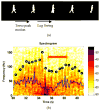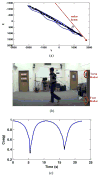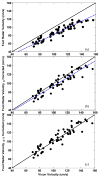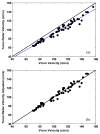Quantitative gait measurement with pulse-Doppler radar for passive in-home gait assessment
- PMID: 24771566
- PMCID: PMC4238914
- DOI: 10.1109/TBME.2014.2319333
Quantitative gait measurement with pulse-Doppler radar for passive in-home gait assessment
Abstract
In this paper, we propose a pulse-Doppler radar system for in-home gait assessment of older adults. A methodology has been developed to extract gait parameters including walking speed and step time using Doppler radar. The gait parameters have been validated with a Vicon motion capture system in the lab with 13 participants and 158 test runs. The study revealed that for an optimal step recognition and walking speed estimation, a dual radar set up with one radar placed at foot level and the other at torso level is necessary. An excellent absolute agreement with intraclass correlation coefficients of 0.97 was found for step time estimation with the foot level radar. For walking speed, although both radars show excellent consistency they all have a system offset compared to the ground truth due to walking direction with respect to the radar beam. The torso level radar has a better performance (9% offset on average) in the speed estimation compared to the foot level radar (13%-18% offset). Quantitative analysis has been performed to compute the angles causing the systematic error. These lab results demonstrate the capability of the system to be used as a daily gait assessment tool in home environments, useful for fall risk assessment and other health care applications. The system is currently being tested in an unstructured home environment.
Figures










Similar articles
-
Remote Gait Analysis Using Ultra-Wideband Radar Technology Based on Joint Range-Doppler-Time Representation.IEEE Trans Biomed Eng. 2024 Oct;71(10):2854-2865. doi: 10.1109/TBME.2024.3396650. Epub 2024 Sep 19. IEEE Trans Biomed Eng. 2024. PMID: 38700960
-
Toward a passive low-cost in-home gait assessment system for older adults.IEEE J Biomed Health Inform. 2013 Mar;17(2):346-55. doi: 10.1109/JBHI.2012.2233745. IEEE J Biomed Health Inform. 2013. PMID: 24235111 Free PMC article.
-
Capturing gait parameters during asymmetric overground walking using ultra-wideband radars: A preliminary study.Annu Int Conf IEEE Eng Med Biol Soc. 2024 Jul;2024:1-4. doi: 10.1109/EMBC53108.2024.10781811. Annu Int Conf IEEE Eng Med Biol Soc. 2024. PMID: 40039302
-
Toward Unobtrusive In-Home Gait Analysis Based on Radar Micro-Doppler Signatures.IEEE Trans Biomed Eng. 2019 Sep;66(9):2629-2640. doi: 10.1109/TBME.2019.2893528. Epub 2019 Jan 16. IEEE Trans Biomed Eng. 2019. PMID: 30668460
-
Single-Camera-Based Method for Step Length Symmetry Measurement in Unconstrained Elderly Home Monitoring.IEEE Trans Biomed Eng. 2017 Nov;64(11):2618-2627. doi: 10.1109/TBME.2017.2653246. IEEE Trans Biomed Eng. 2017. PMID: 28092516
Cited by
-
Comparative Analysis of Gait Speed Estimation Using Wideband and Narrowband Radars, Thermal Camera, and Motion Tracking Suit Technologies.J Healthc Inform Res. 2020 Apr 16;4(3):215-237. doi: 10.1007/s41666-020-00071-7. eCollection 2020 Sep. J Healthc Inform Res. 2020. PMID: 35415448 Free PMC article.
-
Short term Heart Rate Variability to predict blood pressure drops due to standing: a pilot study.BMC Med Inform Decis Mak. 2015;15 Suppl 3(Suppl 3):S2. doi: 10.1186/1472-6947-15-S3-S2. Epub 2015 Sep 4. BMC Med Inform Decis Mak. 2015. PMID: 26391336 Free PMC article.
-
Automated Health Alerts Using In-Home Sensor Data for Embedded Health Assessment.IEEE J Transl Eng Health Med. 2015 Apr 10;3:2700111. doi: 10.1109/JTEHM.2015.2421499. eCollection 2015. IEEE J Transl Eng Health Med. 2015. PMID: 27170900 Free PMC article.
-
Automated extraction and validation of children's gait parameters with the Kinect.Biomed Eng Online. 2015 Dec 2;14:112. doi: 10.1186/s12938-015-0102-9. Biomed Eng Online. 2015. PMID: 26626555 Free PMC article.
-
State-of-the-Art Wearable Sensors and Possibilities for Radar in Fall Prevention.Sensors (Basel). 2021 Oct 14;21(20):6836. doi: 10.3390/s21206836. Sensors (Basel). 2021. PMID: 34696046 Free PMC article. Review.
References
-
- Marek KD, Popejoy L, Petroski G, Mehr D, Rantz M, Lin WW. Clinical outcomes of aging in place. Nursing Res. 2005;54(3):202–211. - PubMed
-
- Hausdorff JM, Rios DA, Edelber HK. Gait variability and fall risk in community–living older adults: A 1–year prospective study. Archives Phys Med Rehabil. 2001;82(8):1050–1056. - PubMed
-
- Hornbrook MC, Stevens VJ, Wingfield DJ, Hollis JF, Greenlick MR, Ory MG. Preventing falls among community–dwelling older persons: Results from a randomized trial. Gerontologist. 1994;34(1):16–23. - PubMed
-
- Stevens JA. Fatalities and injuries from falls among older adults—United States, 1993–2003 and 2001–2005. Morb Mortal Wkly Rep. 2006;55(45):1221–1224. - PubMed
-
- Barak Y, Wagenaar RC, Holt KG. Gait characteristics of elderly people with a history of falls: A dynamic approach. Phys Therapy. 2006;86(11):1501–1510. - PubMed
Publication types
MeSH terms
Grants and funding
LinkOut - more resources
Full Text Sources
Other Literature Sources
Miscellaneous

